MONTEREY COUNTY HIGHLIGHTS: 2001
Text by Don Roberson
These highlights chronicle the second half of the year 2001. They were
created incrementally and reposted as new photos were available so the
year runs generally "backwards" on this page. Highlights from January through
June 2001 are now on
a second page. The abbreviation "MTY" means "Monterey
County" in the text below. Photos on this page are copyrighted by the photographers
to whom they are attributed, and may not be reproduced in any form
(including other web sites) without the express consent of the photographer.
You can check on current rarities on the BirdBox at 831-626-6605, sponsored
by the Monterey Peninsula Audubon Society.
 The
final bird of local interest reported in 2001 was this Rock Wren (right;
© 2001 Don Roberson) found on 31 December along the rocky shoreline
of Pebble Beach, just south of Pt. Joe, by Bob Tintle. There are only a
tiny handful of records for this interior species on the Monterey Peninsula.
It is possible this is the same Rock Wren seen nearby almost two months
earlier (4 Nov by Rick Fournier).
The
final bird of local interest reported in 2001 was this Rock Wren (right;
© 2001 Don Roberson) found on 31 December along the rocky shoreline
of Pebble Beach, just south of Pt. Joe, by Bob Tintle. There are only a
tiny handful of records for this interior species on the Monterey Peninsula.
It is possible this is the same Rock Wren seen nearby almost two months
earlier (4 Nov by Rick Fournier).
The Monterey Peninsula Christmas Bird Count on 29 December was held
under rainy skies. Some 171 species were found on a cold, drippy day (not
including a Redhead just a quarter-mile outside the count circle on Ft.
Ord). Steve Rovell led the countdown where we heard about such rarities
as Virginia's and Lucy's Warblers in Caledonia Park, Pacific Grove; two
N. Rough-winged Swallows in Carmel Valley (very rare in winter); a half-dozen
Barn Swallows in the vanguard of a flood of winter sightings early in 2002;
two male Harlequin Ducks off Del Monte Beach; and one each Summer Tanager,
Hooded Oriole, and Chipping Sparrow in Monterey. A juv. male Yellow-bellied
Sapsucker in Caledonia Park, seen both before and after the count, slipped
by unobserved on count day. The Monterey Bay Christmas Bird Count over
that weekend added a Laysan Albatross and Manx Shearwater to a December
of interest. The Big Sur Christmas Bird Count on 19 December had fine weather
but not much to brag about beyond a very tantalizing glimpse of a Pileated
Woodpecker...
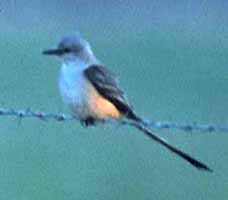 November fizzled in comparison with the early fall, and even an attempted
24 hour pelagic trip to the Davidson Seamount was aborted by midnight 4
November due to heavy seas. But that very day Bernardo Alps, driving up
the coast for the trip, located this Scissor-tailed Flycatcher (left;
© 2001 Bernardo Alps) sitting on a fenceline along Hwy 1 just south
of Pt. Sur. It was the only sighting of this fine rarity all fall. The
only other November birds of real note were an American Tree Sparrow
banded by BSOL on the 17th (Sarah Hamilton), and a McCown's Longspur
east of Gonzales on the 18th (Bob Tintle, Blake Matheson; possibly the
same bird here last fall that represented the first MTY record?).
November fizzled in comparison with the early fall, and even an attempted
24 hour pelagic trip to the Davidson Seamount was aborted by midnight 4
November due to heavy seas. But that very day Bernardo Alps, driving up
the coast for the trip, located this Scissor-tailed Flycatcher (left;
© 2001 Bernardo Alps) sitting on a fenceline along Hwy 1 just south
of Pt. Sur. It was the only sighting of this fine rarity all fall. The
only other November birds of real note were an American Tree Sparrow
banded by BSOL on the 17th (Sarah Hamilton), and a McCown's Longspur
east of Gonzales on the 18th (Bob Tintle, Blake Matheson; possibly the
same bird here last fall that represented the first MTY record?).
Although the 24 hour boat trip did not materialize, highlights of regular
daily trips on Monterey Bay this autumn included a Streaked Shearwater
on 6 October about 12 mi west of Pt. Pinos (Todd McGrath, Shearwater Journeys)
and a Greater Shearwater just into the SCZ side of Monterey Bay
on 8 October (Jim Danzenbaker +).
[And while the late fall was rather slow here in Monterey, it was local
birder Rob Fowler who was among a pick-up team doing a San Joaquin County
big day that stumbled upon the Demoiselle Crane out in the Central Valley,
a
sighting that led a flood of observers to that little-worked spot and engendered
much discussion over the controversial crane. It seems unlikely that the
crane was a true vagrant from central Asia, but it was nevertheless a lovely
bird to observe among the thousands of Sandhills present.]


The mid-October excitement was created by Alex Cruz who found an interesting
tanager at Laguna Grande Park in Seaside on 14 October. He made field sketches
that helped him identify the bird as a male Scarlet TanagerPiranga
olivacea in a basic plumage when he returned home, and then turned
the field sketches into some great watercolors (one is at right;
© 2001 Alexander Cruz, Jr., reposted here with permission). He called
the BirdBox that evening and many locals were present the next morning,
including Bill Hill who obtained this photo (above; © 2001
Bill Hill; more
on his website) of the bird as it ate a blackberry. The tanager fed
on bees, wasps, and berries over the next few days, and was seen daily
(if erratically) through 17 October. This was just the second MTY record,
and the date span closely mirrored the previous bird (also a male) at the
Carmel R. mouth 11-17 Oct 1987.
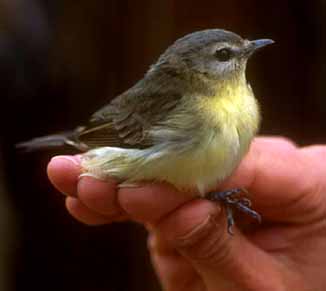 After
a brief lull at the turn of the month, early October picked up with a plethora
of eastern vagrants, including multiple Chestnut-sided, Magnolia &
Prairie warblers and Baltimore Orioles (including 3 together in Pacific
Grove 8 Oct). The rarest species in the set was this Philadelphia Vireo
banded by Big Sur Ornithology Lab (left; photo © D. Roberson)
that was later refound the same day (6 Oct) in a mixed feeding flock. [A
mid-September report of this species in Carmel went undocumented and thus
will not be included in the county database unless a description is received.
Any details are still welcome;
email
them here]. There were also a few scattered Tropical Kingbirds, and
the arrival of numerous wintering species. Two interesting wigeon that
arrived at the Carmel R. mouth 9 Oct and remained to about month's end
engendered much comment; see
my full page about these hatch-year Eurasian Wigeon.
After
a brief lull at the turn of the month, early October picked up with a plethora
of eastern vagrants, including multiple Chestnut-sided, Magnolia &
Prairie warblers and Baltimore Orioles (including 3 together in Pacific
Grove 8 Oct). The rarest species in the set was this Philadelphia Vireo
banded by Big Sur Ornithology Lab (left; photo © D. Roberson)
that was later refound the same day (6 Oct) in a mixed feeding flock. [A
mid-September report of this species in Carmel went undocumented and thus
will not be included in the county database unless a description is received.
Any details are still welcome;
email
them here]. There were also a few scattered Tropical Kingbirds, and
the arrival of numerous wintering species. Two interesting wigeon that
arrived at the Carmel R. mouth 9 Oct and remained to about month's end
engendered much comment; see
my full page about these hatch-year Eurasian Wigeon.
In late September two birds of great local interest were discovered.
On 23 Sep 2001, Rob Fowler found this young Phainopepla (below;
photo © D. Roberson) near the corner of Acropolis & Shell in Pacific
Grove where it stayed the entire day, flycatching from the top of a scrubby
live oak . It represents the first record for the entire Monterey Peninsula.
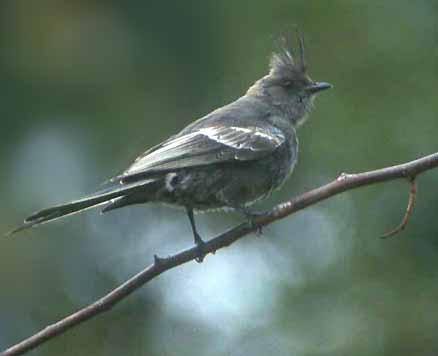 Two days later, among a wave of new arrivals following a stormy lightening-accented
night, Don Roberson found an imm. Calliope Hummingbird at Pt. Pinos.
His sketch (below in colored pencil) accompanies a full written description.
Two days later, among a wave of new arrivals following a stormy lightening-accented
night, Don Roberson found an imm. Calliope Hummingbird at Pt. Pinos.
His sketch (below in colored pencil) accompanies a full written description.

This is the first Calliope ever found in fall migration (two prior
reports of adult males in Oct & Nov 1975 are inadequately documented;
adults males should be well south of the U.S. by those dates). There are
7 prior Pacific Grove records, all during the last two weeks of April in
spring migration.
| Mid-September saw a number of good birds banded or seen at the Big
Sur R. mouth, including this Worm-eating Warbler
banded 19 Sep and recaptured 20 Sep by Big Sur Ornithology Lab (digital
photo right by Jason Scott, courtesy
Ventana Wilderness Society). Other more typical vagrants banded there in
September included American Redstart and
Northern Waterthrush, and Chestnut-sided Warbler
and
Red-eyed Vireo were seen nearby. On 22 September, Rita Carratello
& Don Roberson saw a Northern Goshawk
-- only the 3rd MTY record -- fly across the main trail near the river
mouth itself.
It seems to be a banner fall for Tennessee Warblers
with a half-dozen reported by mid-month from five sites, including a bird
bath in Pacific Grove that also hosted a Chestnut-sided
Warbler a couple days later (Rita Carratello). |
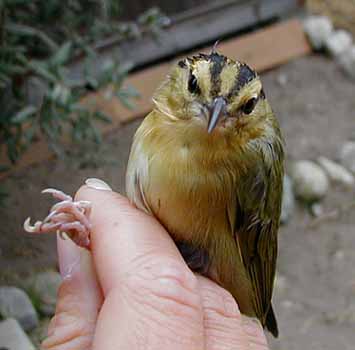
|
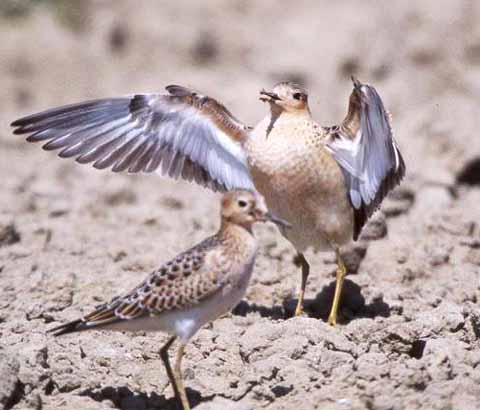
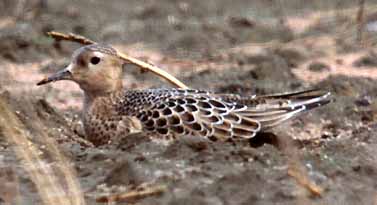
Rita Carratello & Don Roberson discovered two Buff-breasted
Sandpipers while birding a permit-only site in the lower Salinas Valley
on 9 September. They were able to reach Bill Hill and John Sorensen by
phone to come and document the record: a Bill Hill
photo is above; one of the John
Sorensen shots (left) shows unusual territorial defense maneuvers.
What could provoke such behaviors in juvenal birds during migration? Very
unusual and interesting. Carleton Eyster found another Buff-breasted
Sandpiper on public property at the pond at Salinas R. mouth NWR on
13 September. Yet a 4th was near Salinas at least 19-23 Sep (B. H. Gerow).
These are the first "Buffies" in MTY since 1993.
| The fall vagrant passerine season began, as is often typical, with
a couple Northern Waterthrushes at Carmel & Big Sur R. mouths but then
the Big Sur Ornithology Lab raised the stakes dramatically by capturing
this young Painted Bunting on 5 September (right; photo by Jason
Scott). Could we possibly see another fall like last fall when four
were near Big Sur, including three banded by BSOL? Photos of those previous
three banded birds are on the Year
2000 Highlights page. Also in early September, Jason had Virginia's
Warbler, Tennessee Warbler, and American Redstart in the chickadee flocks
he was studying along the Big Sur River, and others had Prairie Warbler
and Rose-breasted Grosbeak there. |
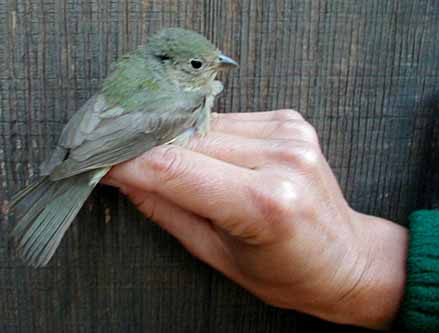 |
| Shorebirding was reasonably good in August with several juvenal Ruff,
including this one (right in a great shot by John Sorensen) at the
Carmel R. mouth 22-23 August. When one considers the Red-necked Stint from
July (see below) and the Common Greenshanks up in Humboldt County in early
September, one might wonder if this will prove to be a great shorebird
year.
For the second year in a row American White Pelicans made summer
news. Large numbers were being seen from the Salinas R. mouth (e.g., 124
on 11 Aug) to the Pajaro R. mouth (~140 in flight overhead on 25 Aug).
A group of 42 peeled off from that flock and headed south; Rita Carratello
& Don Roberson followed them to Jetty Rd. on Moss Landing harbor (photo
below © D. Roberson) where they joined diving Brown Pelican to feed
in mass formation on running bait fish. We know of no previous record of
White Pelicans actually feeding in Moss Landing harbor. |
 |

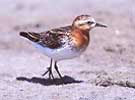 The most exciting discovery of the summer was by Doug George who came upon
this Red-necked Stint Calidris ruficollis (left in
an absolutely stunning photo by John Sorensen). Doug is the primary
field researcher on Snowy Plovers around Moss Landing and discovered the
bird while doing plover work. Longtime residents may recall that it was
Snowy Plover researchers, including George, who discovered Wilson's Plover
in Moss Landing back in September 1992 (and that find led to Clay Kempf's
discovery of a Mongolian Plover in the same Snowy flock for a double treat
that autumn). Unfortunately for birders the stint was in an extremely sensitive
closed area during the peak of Snowy Plover hatching & fledging, and
public access was impossible. It was present only two days (13-14 July
2001) but Doug did arrange for it to be documented, including some wonderful
photographs by Sorensen. This is the first Monterey County record
of Red-necked Stint. To date, all acceptable records in California have
been of alternate-plumaged individuals. Two have been in spring (early
May & mid-June) and the remaining half-dozen or so have been adults
in July during the early part of fall migration.
The most exciting discovery of the summer was by Doug George who came upon
this Red-necked Stint Calidris ruficollis (left in
an absolutely stunning photo by John Sorensen). Doug is the primary
field researcher on Snowy Plovers around Moss Landing and discovered the
bird while doing plover work. Longtime residents may recall that it was
Snowy Plover researchers, including George, who discovered Wilson's Plover
in Moss Landing back in September 1992 (and that find led to Clay Kempf's
discovery of a Mongolian Plover in the same Snowy flock for a double treat
that autumn). Unfortunately for birders the stint was in an extremely sensitive
closed area during the peak of Snowy Plover hatching & fledging, and
public access was impossible. It was present only two days (13-14 July
2001) but Doug did arrange for it to be documented, including some wonderful
photographs by Sorensen. This is the first Monterey County record
of Red-necked Stint. To date, all acceptable records in California have
been of alternate-plumaged individuals. Two have been in spring (early
May & mid-June) and the remaining half-dozen or so have been adults
in July during the early part of fall migration.
In years past there have been claims of breeding plumaged Red-necked
Stints that have likely been Sanderlings in breeding (=alternate) plumage.
Unless one lives on the coast and go shorebirding in July, one may be unfamiliar
with this plumage of Sanderling. One really cool thing you can notice on
John Sorensen's photo of the Red-necked Stint is the presence of a hind
toe (the short toe pointing backwards). Sanderling is the only shorebird
to lack this toe, presumably as an adaptation to running swiftly on beaches.
This point is not usually discussed in wader literature but is mentioned
by Dennis Paulson in his wonderful 1993 book Shorebirds of the Pacific
Northwest. The classic identification papers on stints remain Jonsson
& Grant (1984) and Veit & Jonsson (1987).
Literature cited:
Jonsson, L., and P. J. Grant. 1984. Identification of stints
and peeps. British Birds 77: 293-315
Veit, R., and L. Jonsson. 1987. Field identification of smaller sandpipers
within the genus Calidris. Amer. Birds 41: 212-236
TOP
BACK TO MONTEREY
COUNTY PAGE
GO TO HIGHLIGHTS
FROM 1999
GO TO HIGHLIGHTS
FROM 2000
GO TO HOME PAGE
GO TO
IDENTIFICATION PAGE
GO TO BIRD FAMILIES
OF THE WORLD
Page initiated 28 Feb 2001, last updated 31 Dec 2001
 The
final bird of local interest reported in 2001 was this Rock Wren (right;
© 2001 Don Roberson) found on 31 December along the rocky shoreline
of Pebble Beach, just south of Pt. Joe, by Bob Tintle. There are only a
tiny handful of records for this interior species on the Monterey Peninsula.
It is possible this is the same Rock Wren seen nearby almost two months
earlier (4 Nov by Rick Fournier).
The
final bird of local interest reported in 2001 was this Rock Wren (right;
© 2001 Don Roberson) found on 31 December along the rocky shoreline
of Pebble Beach, just south of Pt. Joe, by Bob Tintle. There are only a
tiny handful of records for this interior species on the Monterey Peninsula.
It is possible this is the same Rock Wren seen nearby almost two months
earlier (4 Nov by Rick Fournier).
 November fizzled in comparison with the early fall, and even an attempted
24 hour pelagic trip to the Davidson Seamount was aborted by midnight 4
November due to heavy seas. But that very day Bernardo Alps, driving up
the coast for the trip, located this Scissor-tailed Flycatcher (left;
© 2001 Bernardo Alps) sitting on a fenceline along Hwy 1 just south
of Pt. Sur. It was the only sighting of this fine rarity all fall. The
only other November birds of real note were an American Tree Sparrow
banded by BSOL on the 17th (Sarah Hamilton), and a McCown's Longspur
east of Gonzales on the 18th (Bob Tintle, Blake Matheson; possibly the
same bird here last fall that represented the first MTY record?).
November fizzled in comparison with the early fall, and even an attempted
24 hour pelagic trip to the Davidson Seamount was aborted by midnight 4
November due to heavy seas. But that very day Bernardo Alps, driving up
the coast for the trip, located this Scissor-tailed Flycatcher (left;
© 2001 Bernardo Alps) sitting on a fenceline along Hwy 1 just south
of Pt. Sur. It was the only sighting of this fine rarity all fall. The
only other November birds of real note were an American Tree Sparrow
banded by BSOL on the 17th (Sarah Hamilton), and a McCown's Longspur
east of Gonzales on the 18th (Bob Tintle, Blake Matheson; possibly the
same bird here last fall that represented the first MTY record?).

 After
a brief lull at the turn of the month, early October picked up with a plethora
of eastern vagrants, including multiple Chestnut-sided, Magnolia &
Prairie warblers and Baltimore Orioles (including 3 together in Pacific
Grove 8 Oct). The rarest species in the set was this Philadelphia Vireo
banded by Big Sur Ornithology Lab (left; photo © D. Roberson)
that was later refound the same day (6 Oct) in a mixed feeding flock. [A
mid-September report of this species in Carmel went undocumented and thus
will not be included in the county database unless a description is received.
Any details are still welcome;
After
a brief lull at the turn of the month, early October picked up with a plethora
of eastern vagrants, including multiple Chestnut-sided, Magnolia &
Prairie warblers and Baltimore Orioles (including 3 together in Pacific
Grove 8 Oct). The rarest species in the set was this Philadelphia Vireo
banded by Big Sur Ornithology Lab (left; photo © D. Roberson)
that was later refound the same day (6 Oct) in a mixed feeding flock. [A
mid-September report of this species in Carmel went undocumented and thus
will not be included in the county database unless a description is received.
Any details are still welcome;
 Two days later, among a wave of new arrivals following a stormy lightening-accented
night, Don Roberson found an imm. Calliope Hummingbird at Pt. Pinos.
His sketch (below in colored pencil) accompanies a full written description.
Two days later, among a wave of new arrivals following a stormy lightening-accented
night, Don Roberson found an imm. Calliope Hummingbird at Pt. Pinos.
His sketch (below in colored pencil) accompanies a full written description.







 The most exciting discovery of the summer was by Doug George who came upon
this Red-necked Stint Calidris ruficollis (left in
an absolutely stunning photo by John Sorensen). Doug is the primary
field researcher on Snowy Plovers around Moss Landing and discovered the
bird while doing plover work. Longtime residents may recall that it was
Snowy Plover researchers, including George, who discovered Wilson's Plover
in Moss Landing back in September 1992 (and that find led to Clay Kempf's
discovery of a Mongolian Plover in the same Snowy flock for a double treat
that autumn). Unfortunately for birders the stint was in an extremely sensitive
closed area during the peak of Snowy Plover hatching & fledging, and
public access was impossible. It was present only two days (13-14 July
2001) but Doug did arrange for it to be documented, including some wonderful
photographs by Sorensen. This is the first Monterey County record
of Red-necked Stint. To date, all acceptable records in California have
been of alternate-plumaged individuals. Two have been in spring (early
May & mid-June) and the remaining half-dozen or so have been adults
in July during the early part of fall migration.
The most exciting discovery of the summer was by Doug George who came upon
this Red-necked Stint Calidris ruficollis (left in
an absolutely stunning photo by John Sorensen). Doug is the primary
field researcher on Snowy Plovers around Moss Landing and discovered the
bird while doing plover work. Longtime residents may recall that it was
Snowy Plover researchers, including George, who discovered Wilson's Plover
in Moss Landing back in September 1992 (and that find led to Clay Kempf's
discovery of a Mongolian Plover in the same Snowy flock for a double treat
that autumn). Unfortunately for birders the stint was in an extremely sensitive
closed area during the peak of Snowy Plover hatching & fledging, and
public access was impossible. It was present only two days (13-14 July
2001) but Doug did arrange for it to be documented, including some wonderful
photographs by Sorensen. This is the first Monterey County record
of Red-necked Stint. To date, all acceptable records in California have
been of alternate-plumaged individuals. Two have been in spring (early
May & mid-June) and the remaining half-dozen or so have been adults
in July during the early part of fall migration.